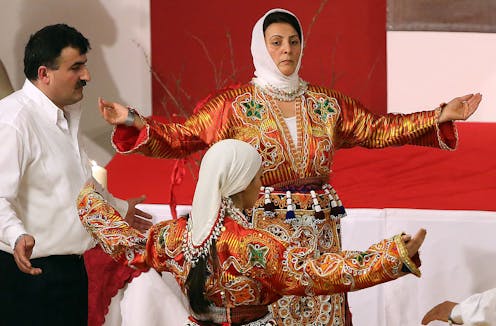Listening to nonhumans: What music can teach about humanity’s relationships with nature and the divine
- Written by Jeffers Engelhardt, Professor of Music, Amherst College
 Members of the Alevi Muslim community perform a ritual semah dance during celebrations for Norooz, or the Persian New Year, in Berlin.Adam Berry/Getty Images
Members of the Alevi Muslim community perform a ritual semah dance during celebrations for Norooz, or the Persian New Year, in Berlin.Adam Berry/Getty ImagesAs someone who teaches and researches music and religion, I’ve always been curious about inspiration and how it connects humans to other beings.
Musicians can be inspired by great artists, living and dead; by technologies that expand their experience, like artist Brian House’smacrophones that capture low-frequency infrasound; by plants and animals; and by the unseen, unheard presence of the supernatural. After all, the word inspiration is rooted in the Latin for “breathing in.” Often, it was associated with spiritual or divine influence – inspiration coming from other realms.
In my research and teaching, recognizing non-human beings is ethically important and an act of intellectual humility. It ensures that I honor other people’s religious and musical experiences, and it admits that we cannot know precisely what they know. One person’s reality may not translate to our own understanding.
That’s what led me to design this course: “Music, Sound and Research with Non-Humans.”
What does the course explore?
The “with” in the course title is key: I want students to learn about how human knowledge exists in relationship with non-humans. To do this, we read and listen widely.
In research using Actor-Network Theory, for example, relationships between humans and non-humans are central: musicians, scientists and their instruments; you and your smartphone; humans and gods. In each case, humans and non-humans are both considered actors – beings that make a real difference in the world.
Music scholar Peter McMurray uses a similar lens in his work on Alevi “semah” ritual, which involves music, movement and poetry. Alevism is a mystical tradition of Islam in Turkey that has long faced discrimination. Some of the sung poetry used for semah is inspired by sacred animals, such as cranes. In semah, participants experience cranelike flight through music and dance, which are central to Alevi ritual.
Dance is an important part of Alevi semah.Or consider traditions of chanting revealed in texts like the Quran, which means “recitation” in Arabic. Spiritually, the purpose is not only to learn the scripture, but to draw closer to its sonic essence. Recitation recalls moments of encounter between humans and the divine, most important being the Prophet Muhammad receiving the Quran through the Angel Gabriel.
We also look beyond music, to everything from medicine and biology to economics, to study relationships between humans and non-humans. One of our favorite readings, for example, is “The Mushroom at the End of the World” by anthropologist Anna Lowenhaupt Tsing. This is a rich ethnographic account of the relationships between humans and matsutake mushrooms, which are highly prized in Japanese cuisine: the piney forests where matsutake grow, the human activities that make them thrive, the foragers who collect them, and the global markets where they are traded.
My students Luana Espinoza and Sofia Ahmed Seid describe our course as exploring a kind of symbiosis: the word biologists use to describe close, often mutually beneficial, relationships between species.
What’s a critical lesson from the course?
This course readies students to confront serious, challenging forms of intellectual diversity, considering how the possibilities of different truths and paradigms might inform their research.
Both students this semester are science majors working on senior theses: Espinoza in chemistry and Seid in neuroscience. By reading and listening to others’ accounts of human and non-human relationships, they say they no longer feel required to leave an essential part of themselves at the classroom door.
Music and sound bridge the physical and metaphysical, the natural and the supernatural. Because of this, they are invaluable for encountering complex truths.
Amherst College students Sofia Ahmed Seid and Luana Espinoza contributed to the preparation of this article.
Uncommon Courses is an occasional series from The Conversation U.S. highlighting unconventional approaches to teaching.
Jeffers Engelhardt does not work for, consult, own shares in or receive funding from any company or organization that would benefit from this article, and has disclosed no relevant affiliations beyond their academic appointment.
Authors: Jeffers Engelhardt, Professor of Music, Amherst College

